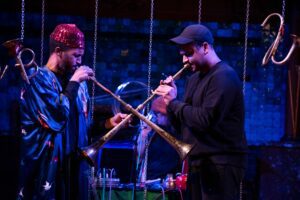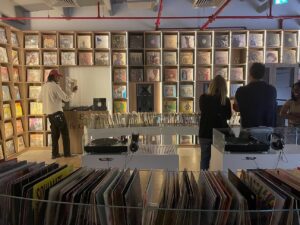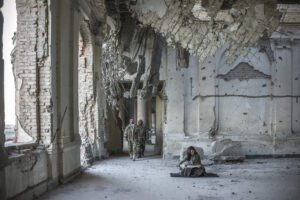Elga Wimmer

This is a journey through music and the visual arts, from New York to Paris to Dubai and back to New York, investigating artists whose work is based on or influenced by music. Throughout history, music and art have been considered a divine match, but how does that pairing translate into contemporary practice?
Today music is instantly available on everyone’s smartphone, creating a sonic atmosphere in every space we move through, from corporate offices to restaurants to gyms. How do visual artists pick and choose from this overload to utilize sound in their sculptures, paintings, videos, films, and performances?
Patrice LeRochereuil, a French artist residing in New York since 1987, manifests an affinity with the Fluxus movement in his performances, drawings, paintings, and sculptures. Sound and music are very prevalent in such works as Do-mi-do Dominos (2018), a painting of a piano whose keys correspond to dominos bearing different numbers, each matching a musical note. Much like Fluxus members Dieter Roth and Wolf Vostell, LeRochereuil sometimes destroys instruments. In his performance Let Me Die… (2018) he created an aggravating sound by drilling holes into a guitar with an electric tool. The artist started the performance by playing a Bob Dylan song on his guitar, then stopped, started drilling, and repeated the process, until the guitar was no longer functional (Zurich, Cabaret Voltaire, 100 years of Dada, 2016). Thus, the guitar punctuated with holes, became a sculpture like a Duchampian readymade. It also recalls a certain violence, but in a poetic and humorous sense, which is the essence of #LeRochereuil’s body of work.
On a recent visit to the Sharjah Biennial, I stopped in Dubai, where I discovered Efie Gallery in the Alserkal district – Dubai’s version of New York’s Chelsea – a contemporary art gallery highlighting work by artists of African origin. After I toured the show of Ethiopian artist Aida Muluneh on the ground floor, gallery director Kwame Mintah led me to the second floor Rekord Gallery, which displays rare vinyl records from around the world. These disks are one of our richest art forms, encompassing the artistry of the cover, the historical specificity of the liner notes, and the music itself. Rekord Gallery is a Pandora’s box of records, including works such as Ikoyi Blindness (1975) by Nigerian artist Fela Kuti, The Word II (1975) by Japanese artist Shigeo Sekito, and Prince of Space, Musik der Leere (1959) by legendary French artist Yves Klein. For the Klein piece, Charles Wilp conducted the Outer Space Philharmonic Orchestra in a no sound recording, the ear detecting only the sound of the needle touching the record. This composition related perfectly to Yves Klein’s 1958 show without art, The Void at Iris Clert in Paris. The gallery, painted white by the artist, exhibited only an empty display case.

At Marclay’s recent show at the Centre Pompidou, a wall was covered with ‘body mixes,’ record covers that are mixed and stacked to form surrealist bodies (the face of David Bowie, the midriff of a female in jeans, the legs of a woman in lace stockings) – a kind of Exquisite Corpse of iconic, sexy album covers, displayed in a playful installation. The wall felt like a visual memorial to pop legends from Diana Ross to Grace Jones, from Bowie to Prince. Marclay perfectly matches high and low art, pop icons and classical conductors, play and politics.
The work of multi-media artist Christian Marclay, based in New York and London, also has its origin in the realm of sound. Since the late 1970s, he has explored the potential of vinyl records bought mostly in flea markets and manipulated manually on turntables, as well as myriad digital samples. He collages diverse fragmentary tracks to create unique sound objects. Like Yves Klein, Marclay is fascinated by the invisibility and seeming immateriality of sound. At the same time, he takes an interest in physical objects relating to music.
What you cannot hear or see is often a major element of Marclay’s work. His installation Guitar Drag (2000) features a video shot in Texas, where the artist dragged an electric guitar behind a pickup truck. The resulting cacophony, channeled through an amplifier, evokes noise music and the destruction of instruments at rock concerts. The Fender Stratocaster, dragged like a body behind the truck, evokes a dark history of Southern slavery and the Blues– as well, more specifically, the murder of James Byrd Jr. near Jasper, Texas, in 1998.
Since the late 1980’s, New York artist Carol #Szymanski has used phonetic symbols, sound, and language to create brass sculptures resembling musical instruments. Szymanski’s practice also includes compositions that are then played on her ‘instruments’ by professional musicians. She points out that the human body and mouth shape the sound that is then transferred to her sculptures. In October 2022, Szymanski presented the world premiere of the Phonemophonic Alphabet Brass Band, a collaboration between the sculptor and avant-garde trumpeter Jaimie Branch. This performance at the historic Park Avenue Armory in Manhattan, featured an aural animation of 26 brass-horn sculptures, whose shapes are based on the phonetic alphabet.
Tahmineh Monzavi is an Iranian artist working in film and photography. Past Continues (2008 -2016) is a series of short films shot in abandoned worn-torn homes and historic buildings in Afghanistan and Iran. There performers dance, sing and recite in their native language, conveying a sense of tragedy. In one of the films on a derelict site – with only a cat wandering through – musician Fazila Zamiri (from Kabul) plays eerie sounds on a rubab (a plucked shell neck lute, the national instrument of Afghanistan). She is a well-known member of the Afghanistan Music Academy. In another film in the series, Iranian artist Ava Darvishi (well known in the theater of Tehran), dances in a ruin to music by her sister, Aftab Darvishi, in a manner reminiscent of the Dance of the Seven Veils (Salome’s dance before King Herod, as presented in Oscar Wilde’s play Salome). The actress and performer, dressed in black veils, expresses profound sorrow and lament. Women in Afghanistan and Iran, despite efforts to make them invisible, have raised their voices to oppose dictatorship and war through what American author Hakim Bey called poetic terrorism, a way to stop people in their tracks by peaceful and poetic demonstration.

Theaster Gates uses music as a means of communicating across social and racial borders, part of his multidisciplinary blend of social practice, activism, performance artist, and visionary urban development. At Documenta 13 (2012), he set up residence in an abandoned hotel, the Huguenot House, with his artist friends, who randomly came together for jam sessions. The performances of The Black Monks of Mississippi made the Huguenot House a central hub for the spiritual life of Documenta 13. This performance was transferred in part to this year’s Sharjah Biennial (February 7 to June 11), with the presentation of the film Billy Sings Amazing Grace (2013), chronicling a rehearsal of The Black Monks. Drawing from Blues in his improvisation, singer Billy Forston gives a heart-wrenching gospel-like performance. The rawness of his delivery is captivating, recalling early Blues greats like Bessie Smith and Blind Lemon Jefferson. Theaster Gates’s work never ceases to surprise!
The symbiosis of music, visual art, and performance prompts a complex emotional response, stimulating several senses at once, unlocking emotions, triggering memories, and inspiring action. The contemporary artists in ‘The Influence of Music in Art’ use that power with great effectiveness.
